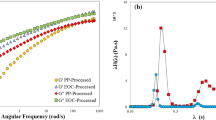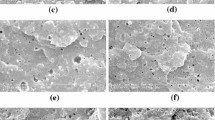Abstract
Interfacial reactions have dominant effects on the morphological and rheological properties of compatibilized polymer blends. This work aims to investigate the effect of epoxy resin, as a coupling agent, on the interface properties and subsequent influences on the morphological and rheological properties of polyethylene terephthalate/polyamide66 (PET/PA66) blend. PET/PA66 70/30 blends with different amount of bisphenol A epoxy resin (0, 1, 3, and 5 wt.%) were prepared. SEM micrographs show reduction in droplet size with increasing epoxy resin concentration, confirming the reactive compatibilizing effect of the epoxy resin. Reactions at the interface of the PET-EP-PA66 blend are confirmed by FTIR spectra. Shear viscosity results demonstrates that adding epoxy resin could suppress the interfacial slip at the blend interphase. Obtained results from storage modulus (G′) curves show the presence of one plateau for the blends at low frequency region; nevertheless, relaxation spectra indicate the presence of two more relaxation mechanisms than precursors which are related to the shape relaxation of droplets and the interface relaxation. The presence of the interface relaxation time in the blend without epoxy resin can prove the presence of reactions between two condensation polymers; however, adding the epoxy resin results in reducing both relaxation time and interfacial tension and increasing interfacial shear modulus. These observations indicate that the epoxy resin has been successful to boost the reactions at the interface between two polymers. Fitting the obtained experimental data using Palierne model indicates that the general Palierne model could describe rheological properties of the blends very well.














Similar content being viewed by others
References
ASTM D4603-96 (1996) Standard test method for determining inherent viscosity of poly (ethylene terephthate) by glass capillary viscometer
ASTM D789-98 (1998) Standard test method for determination of relative viscosity and moisture content of polyamide
Al-AbdulRazzak S, Lofgren EA, Jabarin SA (2002) End-group determination in poly(ethylene terephthalate) by infrared spectroscopy. Polymer Int 51:174–182
Ares A, Silva J, Maia JM, Barral L, Abad MJ (2009) Rheometrical and morphological study of compatibilized PP/EVOH blends. Rheol Acta 48:993–1004
Asthana H, Jayaraman K (1999) Rheology of reactive compatibilized polymer blends withvarying extent of interfacial reaction. Macromolecules 32:3412–3419
Bousmina M (1999) Rheology of polymer blends: linear model forviscoelastic emulsion. Rheol Acta 38:73–83
Bousmina M, Aouina M, Chaudhry B, Guénette R, Rosario ES (2001) Rheology of polymer blends: non-linear model for viscoelastic emulsions undergoing high deformation flows volume. Rheol Acta 40:538–551
Bousmina M, Aouina M, Chaudhry B, Guénette R, Rosario ES (2001) Rheology of polymer blends: non-linear model for viscoelastic emulsions undergoing high deformation flows volume. Rheol Acta 40:538–551
Chin H-C, Chang F-C (1997) Reactive compatibilization of PET/LCP blends by a multifunctional epoxy coupler. Polymer 38:2947–2956
Chiou K-C, Chang F-C (2000) Reactive compatibilization of polyamide-6 (PA 6)/polybutylene terephthalate (PBT) blends by a multifunctional epoxy resin. J Appl Polym Sci 38:23–33
DeLeo C, Velankar S (2011) Effect of compatibilizer concentration and weight fraction on model immiscible blends with interfacial crosslinking. J Rheol 55:713–732
Dharaiya D, Jana S C, Shafi A (2003) A study on the use of phenoxy resins as compatibilizers of polyamide6 and polybutylene terphtalate. Polym Eng Sci 43:580–594
Fahrlander M, Bruch M, Menke T, Friedrich C (2001) Rheological behavior of PS-melts containing surface modified PMMA-particleds. Rheol Acta 40:1–9
Fenouillot F, Hedreul C, Forsythe J, Pascault J.P (2003) Reaction and miscibility of two diepoxides with poly(ethylene terephthalate). J Appl Polym Sci 87:1995–2003
Friedrich C, Antonov Y (2007) Interfacial relaxation in polymer blend and Gibbs elasticity. Macromolecules 40:1283–1289
Graebling D, Muller R, Palierne J. F (1993) Linear viscoelastic behavior of some incompatible polymer blends in the melt. Interpretation of data with a model of emulsion of viscoelastic liquids. Macromolecules 26:320–329
Harani H, Fellahi S, Bakar M (1999) Toughening of epoxy resin using hydroxyl-terminated polyesters. J Appl Polym Sci 71:29–38
Herrero M, Benito P, Labajos FM, Rives V, Zhu YD, Allen GC, Adams JM (2010) Structural characterization and thermal properties of polyamide 6.6/Mg, Al/adipate-LDH nanocomposites obtained by solid state polymerization. J Solid State Chem 183:1645–1651
Honerkamp J, Weese method (1993) A nonlinear regularization method for the calculation of relaxation spectra. Rheol Acta 32:65–73
Huang C-C, Chang F-C (1997) Reactive compatibilization of polymer blends of PBT and PA66:1.Rheological and thermal properties. Polymer 38:2135–2141
Huang Y, Liu Y, Zhao C (1998) Morphology and properties of PET/PA-6/E-44 blends. J Appl Polym Sci 69:1505–1515
Huo Y, Groeninckx G, Moldenaers P (2007) Rheology and morphology of polystyrene/polypropylene blends with in situ compatibilization. Rheol Acta 46:507–520
Jacobs U, Fahrländer M, Winterhalter J, Friedricha Chr (1999) Analysis of Palierne’s emulsion model in the case of viscoelastic interfacial properties. J Rheol 43:1495–1059
Khoshnevis H, Zadhoush A (2001) Investigation of the effect of SSP in stabilization the structure of condensation polymer blends via rheological measurements. Rheol Acta 50:131–140
Kwon Y N, Tang CY, Leckie J O (2006) Hypochlorite degradation of crosslinked polyamidemembranes II Changes in hydrogen bonding behavior and perfor-mance. J Membr Sci 282:456–464
Macosko C W, Jeon H K, Hoye T R (2005) Reaction at polymer–polymer interfaces for blend compatibilization. Progress in Polymer Science 30:939–947
Mechbal N, Bousmina M (2007) Effect of copolymer addition on drop deformation during uniaxial elongation and during relaxation after cessation of flow. Macromolecules 40:967–975
Moan M, Huitric J, Mederic P (2000) Rheological properties and reactive compatibilization of immiscible polymer blends. J Rheol 44:1227–1244
Riemann R-E, Cantow H-J, Friedrich Chr (1997) Interpretation of a new interface-governed relaxation process in compatibilized polymer blend. Macromolecules 30:5476–5484
Shi D, Ke Z, Yang J, Gao Y, Wu J, Yin J (2002) Rheology and morphology of reactively compatibilized PP/PA6 blends. Macromolecules 35:8005–8012
Silva J, Machado A V, Maia J (2007) Rheological behavior of compatibilized PA6/EPM blends. Rheol Acta 46:1091–1097
Silva J, Machado A V, Moldenaers P, Maia J (2010) The effect of interfacial properties on the deformation and relaxation behavior of PMMA/PS blends. J Rheol 54:797–813
Tang CY, Kwon YN, Leckie JO (2009) Effect of membrane chemistry and coating layer on physiochemical properties of thin film composite polyamide RO and NF membranes I. FTIR and XPS characterization of polyamide and coating layer chemistry. Desalination 242:149–167
Tripathi G, Srivasta D (2007) Effect of carboxyl-terminated poly(butadiene-co-acrylonitrile) (CTBN) concentration on thermal and mechanical properties of binary blends of diglycidyl ether of bisphenol-A (DGEBA) epoxy resin. Mater Sci Eng A 443:262–269
Underwood EE (1970) Quantitative sterology. Addison Wesley, Reading
Van Hemelrijck E, Van Puyvelde P (2004) Interfacial elasticity and coalescence suppression in compatibilized polymer blends. J Rheol 48(1):143–158
Van Hemelrijck E, Van Puyvelde P (2005) The effect of block copolymer architecture on the coalescence and interfacial elasticity in compatibilized polymer blend. J Rheol 49(3):783–798
Van Puyvelde P, Velankar S, Moldenaers P (2001) Rheology and morphology of compatibilized polymer blends. Curr Opin Colloid Interface Sci 6:457–463
Van Puyvelde P, Velankar S, Mewis J, Moldenaers P (2002) Effect of Marangoni stresses on the deformation and coalescence in compatibilized immiscible polymer blends. Polym Eng Sci 42:1956–1964
Velankar S, Van puyvelde P, Mewis J, Moldenaers P (2001) Effect of compatibilization on the breakup of polymeric drops in shear flow. J Rheol 45(4):1007–1019
Yee M, Calvão PS, Demarquette NR (2007) Rheological behavior of poly(methyl methacrylate)/polystyrene (PMMA/PS) blends with the addition of PMMA-ran-PS. Rheol Acta 46:653–664
Yee M, Souza A, Valera T, Demarquette N (2009) Stress relaxation behavior of PMMA/PS polymer blends. Rheol Acta 48:527–541
Zhao R, Macosko CW (2002) Slip at polymer–polymer interfaces: rheological measurements on coextruded multilayers. J Rheol 46:145–167
Author information
Authors and Affiliations
Corresponding author
Rights and permissions
About this article
Cite this article
Khoshnevis, H., Zadhoush, A. The influence of epoxy resin on the morphological and rheological properties of PET/PA66 blend. Rheol Acta 51, 467–480 (2012). https://doi.org/10.1007/s00397-011-0615-5
Received:
Revised:
Accepted:
Published:
Issue Date:
DOI: https://doi.org/10.1007/s00397-011-0615-5




